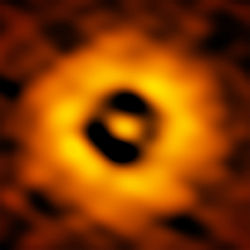TW Hydrae
 Inner region of TW Hydrae protoplanetary disc Credit: S. Andrews, B. Saxton, ALMA (see description) | |
| Observation data Epoch J2000.0 Equinox J2000.0 | |
|---|---|
| Constellation | Hydra |
| Right ascension | 11h 01m 51.9054s[1] |
| Declination | −34° 42′ 17.0316″[1]> |
| Apparent magnitude (V) | 11.27 ± 0.09[2] |
| Characteristics | |
| Evolutionary stage | Pre-main-sequence |
| Spectral type | K6[2] |
| U−B color index | -0.33[3] |
| B−V color index | 0.67[2] |
| J−H color index | 0.659[2] |
| J−K color index | 0.92[2] |
| Variable type | T Tauri |
| Astrometry | |
| Radial velocity (Rv) | 13.40 ± 0.8[2] km/s |
| Proper motion (μ) | RA: −68.389 ± 0.054[1] mas/yr Dec.: −14.016 ± 0.059[1] mas/yr |
| Parallax (π) | 16.6428 ± 0.0416[1] mas |
| Distance | 196.0 ± 0.5 ly (60.1 ± 0.2 pc) |
| Details | |
| Mass | 0.8[4] M☉ |
| Radius | 1.11[5] R☉ |
| Luminosity (bolometric) | 0.28[note 1] L☉ |
| Temperature | 4,000[5] K |
| Age | 8[5] Myr |
| Other designations | |
| Database references | |
| SIMBAD | data |
TW Hydrae is a T Tauri star approximately 196 light-years away[1] in the constellation of Hydra (the Sea Serpent). The star is the closest such star to the Solar System. TW Hydrae is about 80% of the mass of the Sun, but is only about 5-10 million years old. The star appears to be accreting from a face-on protoplanetary disk of dust and gas, which has been resolved in images from the ALMA observatory. TW Hydrae is accompanied by about twenty other low-mass stars with similar ages and spatial motions, comprising the "TW Hydrae association" or TWA, one of the closest regions of recent "fossil" star-formation to the Sun.
Stellar characteristics[]
TW Hydrae is a pre-main-sequence star that is approximately 80% the mass of and 111% the radius of the Sun. It has a temperature of 4000 K and is about 8 million years old. In comparison, the Sun is about 4.6 billion years old[6] and has a temperature of 5778 K.[7] The star's luminosity is 28% (0.28x) that of the Sun, equivalent to that of a main-sequence star of spectral type ~K2. However, the spectral class is K6.
The star's apparent magnitude, or how bright it appears from Earth's perspective, is 11.27. It is too dim to be seen with the naked eye.
Planetary system[]
| Companion (in order from star) |
Mass | Semimajor axis (AU) |
Orbital period (days) |
Eccentricity | Inclination | Radius |
|---|---|---|---|---|---|---|
| b (unconfirmed) | 23.72 M |